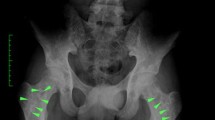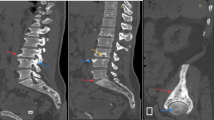Abstract
Background
Ollier’s disease is a non-hereditary, benign bone tumor which is usually characterized by presence of multiple radiolucent lesions (enchondromas) in the metaphysis of long bones with unilateral predominance. The disease is a rare clinical entity with 1/100000 occurrence in early childhood. Patients mostly present with multiple hard swellings and deformity of the tubular bones specially hands and feet with leg discrepancy and pathologic fractures.
Case presentation
We present two cases of Ollier’s disease in a 13 years old female and 8 years old boy which had no specific symptoms. The girl had multiple hard swellings and deformity in the fingers of both hands and left toes with left leg deformity and discrepancy. Her plain radiographs demonstrated multiple expansile enchondromas in the phalanges of hands, left toes and metaphyses of upper humeri as well as left leg bones. The enchondromas were also noted in the left iliac bone and anterior end of ribs. The boy had bowing deformity and shortage of left leg with multiple enchondromas in the metaphyses of left femur, left tibia and fibula as well as left iliac bone in his radiographic images.
Conclusion
Ollier’s disease is usually diagnosed by clinical signs and typical location of enchondromas across skeleton in conventional radiography. It usually does not need specific treatment. Well understanding of the clinical manifestation and radiographic features can prevent unnecessary application of other imaging modalities; while other diagnostic imaging modalities like MRI, ultrasound and scintigraphy can be used in complicated and painful conditions.
Similar content being viewed by others
Background
Multiple enchondromatosis is a rare bone disease with six subtypes. Ollier’s disease is a non-hereditary subtype of the disease which for the first time was introduced by Ollier in 1899 [1, 2]. It is characterized by presence of at least three enchondromas in the appendicular bones. The disease prevalence is 1/100000 of population with almost equal sex distribution and early manifestation in first decade of life [1,2,3]. The patients usually present with multiple hard swellings in the fingers and toes associated with asymmetric deformity of the extremities [4]. The plain radiographs of the affected bones demonstrate various number, size and location of enchondromas in the metaphyses of tubular bones with extension into the diaphyseal and epiphyseal regions [2]. Some of these enchondromas may show expansile behavior called enchondromas protuberance. Clusters of enchondromas cause widening of the metaphyseal regions. In the lower extremities the lesions may result in bone deformity and limb discrepancy. Punctate calcifications with light trabeculations are also seen in the metaphysis of long bones [5]. Sometimes Pelvis bone especially the iliac crest is involved but sternum, ribs and skull bones are rarely affected [1]. In one of the present cases, the enchondromas exist in the anterior ribs representing a rare location of the disease.
Case presentation
First case
A-13 year old girl was referred to the radiology department of French Medical Institute for Mothers and Children (FMIC) for taking plain radiographs of the axial and appendicular bones. The patient had short left leg with abnormal swelling and deformity of fingers and left toes. The swelling were hard in palpation however no pain was noticed. The overlying skin appeared normal. In radiographic images, multiple expansile lytic lesions (enchondromas) were noted in the metacarpi and phalanges of hands with sparing of the index finger of right hand associated with multiple lytic lesions in the distal ulna and radius of both hands with sparing of left distal ulna (Fig. 1). Chest plain image demonstrated multiple enchondromas in the anterior end of the ribs bilaterally as well as proximal metaphyses of both humeri, extending into right humerus diaphysis with multiple punctate like calcifications (Fig. 2). Enchondromas were also noted in the metatarsi and toes of left foot, left distal tibia and fibula in plain image of left foot (Fig. 3). Multiple lytic lesions with punctate calcifications were also seen in the left iliac bone and proximal metaphysis of left femur in anterior posterior radiograph of pelvis bone (Fig. 4). Plain image of left calf showed multiple foci of calcifications with lytic lesion in the left distal femur as well as proximal and distal metaphyses of left tibia and fibula (Fig. 5).
Second case
An 8 year- old boy was referred to our radiology department for taking radiographs of left leg and pelvis bones. The patient had left leg discrepancy with bowing deformity without specific pain. The lateral radiograph of the left leg demonstrates bowing deformity with enchondromas in the distal femur as well as proximal and distal ends of left tibia and fibula (Fig. 6). The anterior posterior radiograph of pelvis and both lower extremities showed lytic lesions in the proximal and distal ends of left femur, tibia, fibula and left iliac bone with deformity and significant left leg discrepancy (Fig. 7).
Discussion and conclusion
The etiology of Ollier’s disease is not well known however abnormal signaling pathways in the proliferation and differentiation of chondrocytes have been proposed which results in the development of intraosseous cartilaginous foci. Some authors have indicated genetic aberrations like heterozygous mutations of PTHR1, IDH1 and IDH2 genes as the pathogenesis of the disease [3]. The disease has specific radiographic features representing unilateral involvement with presence of multiple lytic lesions in the center of tubular bones of hand, foot and long bones particularly in metaphyseal regions. Sometimes there is symmetrical involvement but still with unilateral predominance. Occasionally during the course of the disease pathologic fractures may occur due to the cortical thinning [2]. Ultrasound, Magnetic Resonance Imaging (MRI) and Scintigraphy are used when the lesions increase in size and causing pain. MRI shows lobulated lesions in the affected bones returning intermediate signal intensity in T1 with intermediate to high signal intensity in T2 weighted images [1]. In bone scan multiple foci of radiotracer uptakes are appreciated mainly in the tubular bones [2].The complication of enchondromatosis is its malignant transformation into the chondrosarcoma which can result in cortical erosion and infiltration into the adjacent soft tissues with indistinguishable and irregular outline of the tumor surface [4]. The differential diagnosis of the Ollier’s disease is hereditary multiple exostosis in which the lesions are usually located in the surface of bones rather than in the center (lesions are located in the center of the bones in enchondromatosis) [1]. Another type of multiple enchondromatosis is called Mafucci syndrome which is characterized with presence of multiple enchondromas associated with soft tissue hemangiomas and occasionally lymphangiomas [4]. As the diagnosis of multiple enchondromatosis is based on the clinical features and specific radiographic manifestations therefore the histopathologic examinations are not usually preformed. In cases when malignant transformation is suspected histopathologic exams are necessary. The literature has indicated a 35% progression into the chondrosarcomas [6, 7]. Asymptomatic patients of multiple enchondromatosis do not need medical or surgical treatments but in cases of growth defects, pathologic fractures and malignant transformation surgical intervention is performed [4]. Radiotherapy and chemotherapy are also advised in cases of malignant transformation [8]. It is concluded that Ollier’s disease is a benign bone tumor which is well diagnosed by its unique clinical and radiographic manifestations.
References
Kumar A, Jain VK, Bharadwaj M, Arya RK. Ollier disease: pathogenesis, diagnosis, and management. Orthopedics. 2015;38(6):e497–506.
Fallahi B, Bostani M, Gilani KA, Beiki D, Gholamrezanezhad A. Manifestations of Ollier's disease in a 21-year-old man: a case report. J Med Case Rep. 2009;3(1):7759.
Silve C, Jüppner H. Ollier disease. Orphanet J Rare Dis. 2006;1(1):37.
George S, Ravi Hoisala V, Cicilet S, Sadashiva S. Multiple Enchondromatosis: Olliers disease-a case report. J Clin Diagn Res. 2016;10(1):TD01.
Adam O, Boia E, Mandrusca R, Mejdi R. Enchondroma-tosis-Ollier disease case-report. Jurnalul Pediatrilui. 2009:47-8.
Schwartz HERBERTS, Zimmerman NB, Simon MA, Wroble RR, Millar EA, Bonfiglio M. The malignant potential of enchondromatosis. J Bone Joint Surg Am. 1987;69(2):269–74.
Pansuriya TC, Oosting J, Krenács T, Taminiau AH, Verdegaal SH, Sangiorgi L, et al. Genome-wide analysis of Ollier disease: Is it all in the genes?. Orphanet J Rare Dis. 2011;6(1):2.
Shaheen, Feroze, Nisar Ahmad, Tariq Gojwari, M. Ashraf Teli, Riyaz Resold, and Manjeet Singh. "Multiple Enchondromatosis: Ollier's Disease." (2010).
Acknowledgments
We thank Dr. Jamshid Jalal head of pathology department of FMIC for helping us in sending our manuscript for this journal. We also thank the radiographers of FMIC for taking good quality images.
Funding
No financial support was provided for this study.
Availability of data and materials
Digital plain radiograph of the images have been taken in Radiology department of FMIC. No other specific data and material was included in this case report.
Author information
Authors and Affiliations
Contributions
JS reviewed the literature, drafted the manuscript, editing the manuscript according to journal policy and being the corresponding, NS reviewed the manuscript and brought the necessary changes, HH and SS also did the literature review and helped in writing the manuscript and providing the images. All authors read and approved the final manuscript.
Corresponding author
Ethics declarations
Ethics approval and consent to participate
The article has got approval of exemption from Ethical Review Committee of French Medical institute for Mothers and Children, as case reports are exempted from ethical review according to this institute’s policy. A copy of the ethical Review Committee form is available for review by Editor-in-Chief of this journal on request.
Consent for publication
Written informed consent was obtained from the patients’ fathers for publication of these case reports and accompanying images. A copy of the written consent will be available for review by the Editor-in-Chief of this journal on request.
Competing interests
The authors declare that they have no competing interests.
Publisher’s Note
Springer Nature remains neutral with regard to jurisdictional claims in published maps and institutional affiliations.
Rights and permissions
Open Access This article is distributed under the terms of the Creative Commons Attribution 4.0 International License (http://creativecommons.org/licenses/by/4.0/), which permits unrestricted use, distribution, and reproduction in any medium, provided you give appropriate credit to the original author(s) and the source, provide a link to the Creative Commons license, and indicate if changes were made. The Creative Commons Public Domain Dedication waiver (http://creativecommons.org/publicdomain/zero/1.0/) applies to the data made available in this article, unless otherwise stated.
About this article
Cite this article
Sadiqi, J., Rasouly, N., Hamidi, H. et al. Radiographic features of Ollier’s disease – two case reports. BMC Med Imaging 17, 58 (2017). https://doi.org/10.1186/s12880-017-0230-8
Received:
Accepted:
Published:
DOI: https://doi.org/10.1186/s12880-017-0230-8











